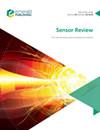用于CO2检测的ZnO基化学电阻传感器综述
IF 1.4
4区 工程技术
Q3 INSTRUMENTS & INSTRUMENTATION
引用次数: 3
摘要
目的二氧化碳(CO2)在过去几年中引起了特别的科学兴趣,主要是因为它与气候变化和室内空气质量有关。除此之外,二氧化碳还可以作为食物新鲜度、患者临床状态和火灾检测的指标。因此,准确监测和控制二氧化碳水平势在必行。开发能够在各种温度、湿度和其他气体干扰条件下有效区分CO2的高灵敏度、选择性和可靠的传感器是深入研究的主题,基于化学电阻氧化锌(ZnO)的传感器占据着特殊地位。几种ZnO纳米结构由于其通用性而被用于传感应用。然而,缺乏选择性和长期稳定性仍然是主要问题,尤其是在室温下操作时。本研究旨在对基于ZnO的CO2化学电阻传感器进行广泛研究,介绍近年来最重要的进展和增强ZnO传感性能的最佳策略。设计/方法/方法概述了用于CO2传感的不同ZnO纳米结构及其合成方法,重点介绍了对传感机制以及CO2传感器性能有很大影响的参数。发现ZnO传感器的选择性和灵敏度可以通过在合成过程中调整各种参数以及用合适的材料掺杂或处理ZnO来提高。原创性/价值本文总结了ZnO传感器在快速发展的CO2传感领域的进展,并为未来优化传感器提供了研究方向。本文章由计算机程序翻译,如有差异,请以英文原文为准。
ZnO-based chemi-resistive sensors for CO2 detection: a review
Purpose
Carbon dioxide (CO2) has attracted special scientific interest over the last years mainly because of its relation to climate change and indoor air quality. Except for this, CO2 can be used as an indicator of food freshness, patients’ clinical state and fire detection. Therefore, the accurate monitoring and controlling of CO2 levels are imperative. The development of highly sensitive, selective and reliable sensors that can efficiently distinguish CO2 in various conditions of temperature, humidity and other gases’ interference is the subject of intensive research with chemi-resistive zinc oxide (ZnO)-based sensors holding a privileged position. Several ZnO nanostructures have been used in sensing applications because of their versatile features. However, the deficient selectivity and long-term stability remain major concerns, especially when operating at room temperature. This study aims to encompass an extensive study of CO2 chemi-resistive sensors based on ZnO, introducing the most significant advances of recent years and the best strategies for enhancing ZnO sensing properties.
Design/methodology/approach
An overview of the different ZnO nanostructures used for CO2 sensing and their synthesis methods is presented, focusing on the parameters that highly affect the sensing mechanism and, thus, the performance of CO2 sensors.
Findings
The selectivity and sensitivity of ZnO sensors can be enhanced by adjusting various parameters during their synthesis and by doping or treating ZnO with suitable materials.
Originality/value
This paper summarises the advances in the rapidly evolving field of CO2 sensing by ZnO sensors and provides research directions for optimised sensors in the future.
求助全文
通过发布文献求助,成功后即可免费获取论文全文。
去求助
来源期刊

Sensor Review
工程技术-仪器仪表
CiteScore
3.40
自引率
6.20%
发文量
50
审稿时长
3.7 months
期刊介绍:
Sensor Review publishes peer reviewed state-of-the-art articles and specially commissioned technology reviews. Each issue of this multidisciplinary journal includes high quality original content covering all aspects of sensors and their applications, and reflecting the most interesting and strategically important research and development activities from around the world. Because of this, readers can stay at the very forefront of high technology sensor developments.
Emphasis is placed on detailed independent regular and review articles identifying the full range of sensors currently available for specific applications, as well as highlighting those areas of technology showing great potential for the future. The journal encourages authors to consider the practical and social implications of their articles.
All articles undergo a rigorous double-blind peer review process which involves an initial assessment of suitability of an article for the journal followed by sending it to, at least two reviewers in the field if deemed suitable.
Sensor Review’s coverage includes, but is not restricted to:
Mechanical sensors – position, displacement, proximity, velocity, acceleration, vibration, force, torque, pressure, and flow sensors
Electric and magnetic sensors – resistance, inductive, capacitive, piezoelectric, eddy-current, electromagnetic, photoelectric, and thermoelectric sensors
Temperature sensors, infrared sensors, humidity sensors
Optical, electro-optical and fibre-optic sensors and systems, photonic sensors
Biosensors, wearable and implantable sensors and systems, immunosensors
Gas and chemical sensors and systems, polymer sensors
Acoustic and ultrasonic sensors
Haptic sensors and devices
Smart and intelligent sensors and systems
Nanosensors, NEMS, MEMS, and BioMEMS
Quantum sensors
Sensor systems: sensor data fusion, signals, processing and interfacing, signal conditioning.
 求助内容:
求助内容: 应助结果提醒方式:
应助结果提醒方式:


